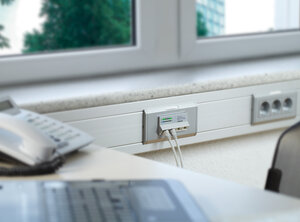
Modern network technology in historic buildings: The Bavarian Ministry of Culture gets its IT environment ready for the future
Prerequisites for Voice-over-IP
For a long time, Fiber To The Desk (FTTD) was considered to be the concept of the future. Today, it is only applied in individual cases any longer. Economic as well as technical reasons usually speak for FTTO, a concept which combines fiber optic with the copper cable. In the case of the Bavarian Ministry of Culture, technical innovations were the driving incentive to search for an alternative to the existing network technology. As soon as in 2013, the migration from ISDN to IP telephony was included in the agenda for the years to come, and the connections in the offices limited to a bandwidth of 100 Mbps frequently proved to be insufficient, as well. In an overall project, the Ministry issued an invitation to tender both for the commissioning for the installation of the backbone infrastructure and for the Gigabit Ethernet connection of the individual offices.
The basic demands made on the micro-switches required in the offices were clearly defined:
- a homogeneous network management system for all components
- simple installation in the cable duct or floor box
- VLANs which are configurable in sufficient numbers
- loop detection is possible
- Power-over-Ethernet to directly operate the future VoIP telephony
With its compact and high-performance Gigabit Ethernet micro-switches, MICROSENS GmbH & Co. KG fulfilled all requirements and were able to win the order from the Ministry as partner of euromicron solutions, the company which delivered and installed all components, including for the backbone area.

Migration According to Schedule
Initially, the first of the two buildings was migrated to the new technology. For this purpose, the responsible project manager of the Federal Ministry, Peter Thoma, and his team divided the buildings into 5 wings. In a first step, the euromicron technicians installed the MICROSENS micro-switches in the cable ducts of the corresponding offices and directly connected them to one of the three available fiber optic connections. After the completion of the work in one wing, only the corresponding optical fibers remained to be reinstalled in the switch. After a retrofitting period of only 10 minutes, all devices were available again, as usual. The two additional optical waveguides are currently no longer required. They can be reactivated at short notice, however, if they are needed again.
Special Requirements Included
During the migration of the second part of the building in spring 2015, a special constructional requirement had to be considered: Here, the micro-switches had to be accommodated in the floor box, but the latter was installed too low in the course of earlier reconstruction measures. Previously, this frequently led to problems, since the bend radiuses of the optical fibers left little room for bending and often caused them to break. Based on the planning made in good time, MICROSENS was able to take this technical restriction into account already when manufacturing the micro-switches, so that the work in the second section of the building could be done smoothly.
Top-level Grades for the Ministry
Someone who collects a lot of points in a test is securing a good grade for himself in class. That's what happened to Peter Thoma in his migration project. "We herewith certify that our new network offers a good performance without any restrictions. It is running in a stable manner and offers ideal prerequisites for the migration to voice-over-IP ahead of us." As a positive side effect, the project leader mentioned additionally that the port density was reduced by two thirds. As only one out of the three optical fibers per room is used, the number of ports required for the switches is reduced, which also decreases the power consumption, as a result. In addition, devices can now be changed much more easily and cost-effectively: While previously the existing 100-Mbps optical waveguide adapter cards first had to be installed in the new device, it is now possible to use all available standard components. Therefore, no retrofitting times are necessary and the network printers can be addressed without problems. In total, the migration from FTTD to FTTO has fulfilled all expectations of the Bavarian Ministry of Culture.
About MICROSENS
Transmitting information via fiber optic connections offers numerous benefits. MICROSENS GmbH & Co. KG recognised this very early on. As one of the pioneers, the company has developed and produced high-performance communications and transmission systems in Germany since 1993. Individually matched to the demands of diverse usage areas and embedded in comprehensive concepts for individual sectors. But, above all, close to the customer. Technical challenges from customer projects are incorporated directly into product development. This way, IP-based automation solutions are created for modern buildings, cost-efficient network concepts for the office and workspace, robust and fail-safe solutions for industrial environments, optical transport systems future-oriented wide area networks and efficient coupling of sites and computer centres.












